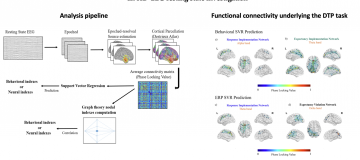
Grounding Adaptive Cognitive Control in the Intrinsic, Functional Brain Organization: An HD-EEG Resting State Investigation
Study published by Gian Marco Duma, Mariagrazia Di Bono and Giovanni Mento in the journal "Brain Sciences".
Is it possible to predict how a person will adapt his motor behavior and neural activity in a cognitive task simply by recording his EEG activity at rest?
In short, it's a bit like figuring out how fast a car runs just by listening to the engine idling....
In this work the authors have reconstructed the cortical activity of 46 healthy adult participants both at rest (resting state) and, subsequently, during an adaptive motor control task (DTP or Dynamic Temporal Prediction task; Duma, Granziol & Mento, Neuroimage) starting from high spatial resolution EEG (128 electrodes). This allowed to measure in each participant the functioning of specific brain circuits associated with distinct computational phases of motor control (e.g., implementation/violation of temporal expectation, implementation of motor response) not only during the actual performance of the task but already several minutes before, during the resting state recording that preceded the task.
Through the use of a machine learning technique known as support vector regression and the application of graph theory measures, it was possible to demonstrate that both behavioral performance (accuracy and ability to adapt motor speed as a function of the task) and neural activity (modulation of task-related responses such as P3 and CNV) are predicted by the characteristics of functional connectivity of both individual nodes (e.g., motor area and frontal and parietal areas) and of the entire network (e.g., network of the implementation/violation of the response).
Put another way, this work clearly demonstrates to me not only that it is possible to measure the intrinsic organization of specific brain circuits at rest through EEG (albeit at high spatial resolution) but also that these measurements can predict aspects of neural functioning and behavioral performance associated with a given task.
These findings provide a small piece of a larger puzzle that will allow us to understand the relationship between how the brain functions at rest (e.g., watching a relaxing video) and under stress (performing a challenging mental task), with obvious possible implications in clinical settings!





